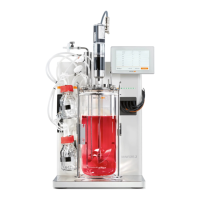
Do you have a question about the Infors HT Minifors 2 and is the answer not in the manual?
| Brand | Infors HT |
|---|---|
| Model | Minifors 2 |
| Category | Laboratory Equipment |
| Language | English |
Describes the manual's purpose, scope, and adherence to safety instructions.
Explains signal words like DANGER, WARNING, CAUTION, and ATTENTION.
Details the information found on the standard identification plate.
Lists EC directives compliance and provides customer service contact details.
Defines proper usage and prohibits misuse or applications outside intended scope.
Specifies qualifications for providers, users, and operators.
Covers electrical, chemical, biological, and physical hazards.
Lists warning symbols attached to the equipment for hazard identification.
Outlines decontamination requirements for returning equipment.
Identifies key parts of the bioreactor's basic unit.
Details the main switch, status LED strip, and peristaltic pumps.
Describes power, water, gas, signal, and motor cable connections.
Explains the culture vessel, its holder, and top plate with port details.
Details the thermal block and adapter system for temperature regulation.
Describes the stirrer mechanism and the gas supply system.
Explains the measurement and control systems for pH, pO2, and foam.
Describes the optional Optek ASD12-N turbidity sensor and its calibration.
Details the optional system for analyzing exit gases using CO2 and O2 sensors.
Lists and describes essential accessories like plugs, adapters, sensors, and filters.
Explains the operation and aseptic sampling procedure.
Provides guidelines for safe internal and external transport of the equipment.
Specifies requirements for storing the equipment and its components.
Covers location requirements, distances, and connecting supply lines.
Guides through performing initial tests for cooling, stirring, heating, and gassing.
Details checking gaskets, mounting components, filling, and autoclaving the vessel.
Covers hanging the vessel, fitting pump heads, filling hoses, and connecting systems.
Explains warming the medium and setting parameters before inoculation.
Describes how to take samples from the culture vessel using the Super Safe Sampler.
Details inoculation via syringe or dip tube/addition port adapter.
Covers harvesting the culture and emptying the vessel and hoses.
Outlines the procedure for autoclaving the vessel after cultivation.
Overview of the main screen layout, menus, and control elements.
Guides through VESSEL TYPE, APPEARANCE, NETWORK SETTINGS, and USB menus.
Explains parameter groups (MAIN, EXTENDED, EXIT GAS, PUMPS) and functions.
Details how to adjust parameter setpoints and configure alarms.
Explains how to link parameters for automated control like pO2.
Details configuration for Pumps 1-4 and AUTO FILL/EMPTY functions.
Provides step-by-step guides for calibrating pH, pO2, and Turbidity sensors.
Explains PID control basics, setting values, and adjustment tips.
Describes how parameter alarms and equipment errors are displayed and managed.
Lists cleaning agents and describes routine cleaning of the culture vessel.
Details the removal of components like top plate, sensors, hoses, and filters.
Covers cleaning sensors, hoses, pump heads, sampling systems, and exit gas coolers.
Describes cleaning the main unit and outlines the maintenance schedule.
Explains the process for removing calcium deposits from the temperature control system.
Lists common problems with the main unit and display, and their solutions.
Addresses issues related to the stirrer motor not starting or operating erratically.
Covers problems related to temperature control, gassing, and pH.
Lists common issues with pO2 control and antifoam systems.
Addresses feed pump issues and procedures for returning equipment for repair.
Provides guidelines for environmentally friendly disassembly and disposal.
Presents physical dimensions of the bioreactor and culture vessels.
Details electrical, water, gas connections, and component specifications.
Lists technical specifications for stirrer, temperature, gassing, and pH systems.
Provides specifications for pO2, antifoam, pumps, and operating environments.